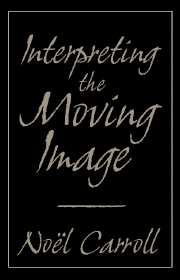Book contents
- Frontmatter
- Contents
- Foreword: Through Carroll's Looking Glass of Criticism
- Introduction
- 1 The Cabinet of Dr. Kracauer
- 2 Entr'acte, Paris and Dada
- 3 The Gold Rush
- 4 Keaton: Film Acting as Action
- 5 Buster Keaton, The General, and Visible Intelligibility
- 6 For God and Country
- 7 Lang, Pabst, and Sound
- 8 Notes on Dreyer's Vampyr
- 9 King Kong: Ape and Essence
- 10 Becky Sharp Takes Over
- 11 Interpreting Citizen Kane
- 12 The Moral Ecology of Melodrama: The Family Plot and Magnificent Obsession
- 13 Mind, Medium, and Metaphor in Harry Smith's Heaven and Earth Magic
- 14 Welles and Kafka
- 15 Nothing But a Man and The Cool World
- 16 Identity and Difference: From Ritual Symbolism to Condensation in Anger's Inauguration of the Pleasure Dome
- 17 Text of Light
- 18 Joan Jonas: Making the Image Visible
- 19 Introduction to Journeys from Berlin/1971
- 20 The Future of Allusion: Hollywood in the Seventies (and Beyond)
- 21 Back to Basics
- 22 Amy Taubin's Bag
- 23 Herzog, Presence, and Paradox
- 24 Film in the Age of Postmodernism
- Notes
- Index
21 - Back to Basics
Published online by Cambridge University Press: 05 June 2012
- Frontmatter
- Contents
- Foreword: Through Carroll's Looking Glass of Criticism
- Introduction
- 1 The Cabinet of Dr. Kracauer
- 2 Entr'acte, Paris and Dada
- 3 The Gold Rush
- 4 Keaton: Film Acting as Action
- 5 Buster Keaton, The General, and Visible Intelligibility
- 6 For God and Country
- 7 Lang, Pabst, and Sound
- 8 Notes on Dreyer's Vampyr
- 9 King Kong: Ape and Essence
- 10 Becky Sharp Takes Over
- 11 Interpreting Citizen Kane
- 12 The Moral Ecology of Melodrama: The Family Plot and Magnificent Obsession
- 13 Mind, Medium, and Metaphor in Harry Smith's Heaven and Earth Magic
- 14 Welles and Kafka
- 15 Nothing But a Man and The Cool World
- 16 Identity and Difference: From Ritual Symbolism to Condensation in Anger's Inauguration of the Pleasure Dome
- 17 Text of Light
- 18 Joan Jonas: Making the Image Visible
- 19 Introduction to Journeys from Berlin/1971
- 20 The Future of Allusion: Hollywood in the Seventies (and Beyond)
- 21 Back to Basics
- 22 Amy Taubin's Bag
- 23 Herzog, Presence, and Paradox
- 24 Film in the Age of Postmodernism
- Notes
- Index
Summary
Vampires from outer space, pirate treasure, time machines, cowboys defending homesteaders, dinosaurs, a half-naked warrior vanquishing hordes of enemies, a house that turns into the biggest popcorn machine in history.
These are the images you would have seen in some of Hollywood's major productions of the past year – in Lifeforce, The Goonies, Back to the Future, Silverado, My Science Project, Rambo: First Blood Part II, and Real Genius.
This list may remind some older Americans of the kinds of movie choices they faced when they were children during the 1930s '40s, or '50s. Those films could be neatly defined – as science fiction, horror, Westerns, war pictures, and slapstick comedies. For critics and moviemakers, these labels, along with others, such as musicals, mysteries, and thrillers, sort out the major film “genres.”
A decade and a half ago, the genre film seemed close to becoming an endangered species. Hollywood had largely turned away from the old standbys, seemingly forever (although it still produced a fair number of them), in favor of more experimental films in the vein of Steelyard Blues and Five Easy Pieces. “What these films – and others – had in common,” writes Arthur Knight, a film historian, “was their articulation of contemporary attitudes and emotions, in a language that had its own modern rhythms and nuances.”
But Hollywood attentively follows ticket sales at the box office, and by the mid-1970s, the movie-going public was telling studio executives that it wanted old-fashioned genre films again.
- Type
- Chapter
- Information
- Interpreting the Moving Image , pp. 265 - 273Publisher: Cambridge University PressPrint publication year: 1998



